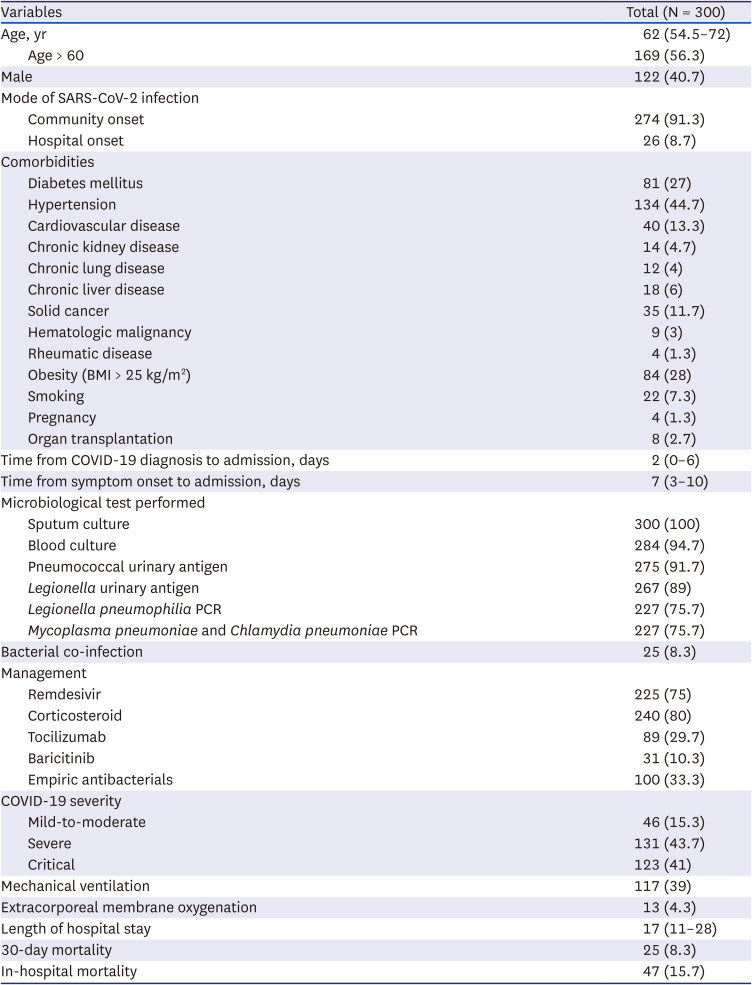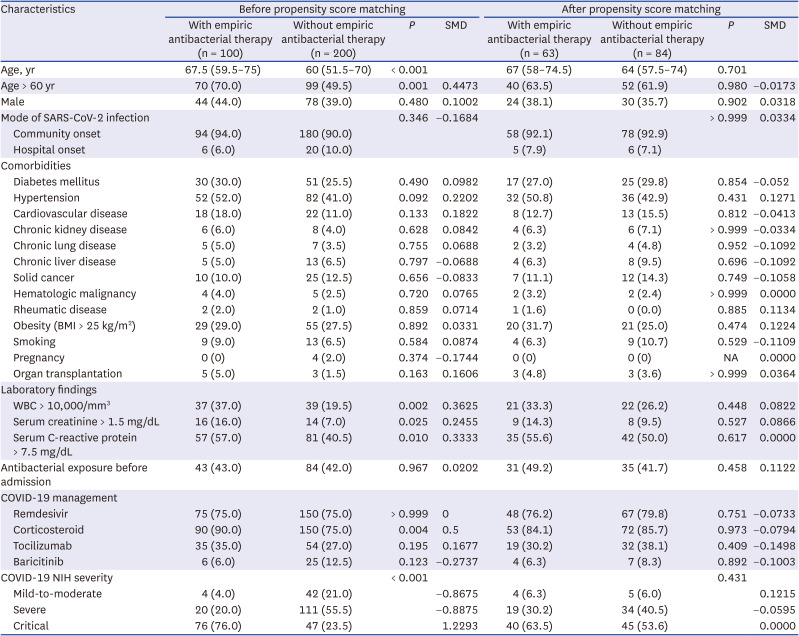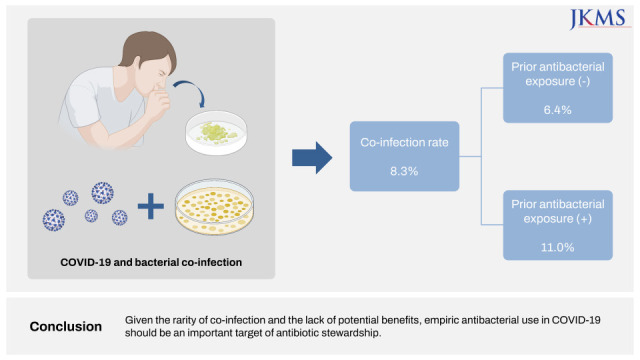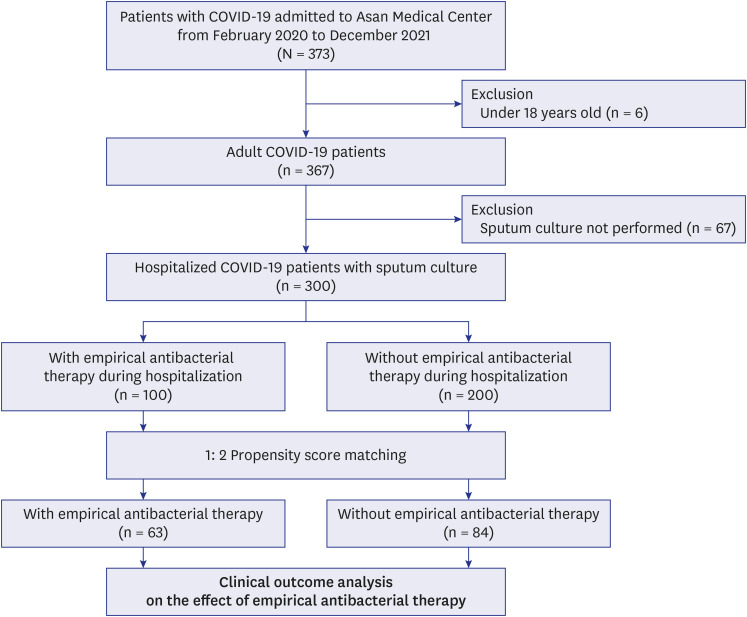1. Zhu N, Zhang D, Wang W, Li X, Yang B, Song J, et al. A novel coronavirus from patients with pneumonia in China, 2019. N Engl J Med. 2020; 382(8):727–733. PMID:
31978945.
2. Chen N, Zhou M, Dong X, Qu J, Gong F, Han Y, et al. Epidemiological and clinical characteristics of 99 cases of 2019 novel coronavirus pneumonia in Wuhan, China: a descriptive study. Lancet. 2020; 395(10223):507–513. PMID:
32007143.
3. Wu Z, McGoogan JM. Characteristics of and important lessons from the coronavirus disease 2019 (COVID-19) outbreak in China: summary of a report of 72 314 cases from the Chinese Center for Disease Control and Prevention. JAMA. 2020; 323(13):1239–1242. PMID:
32091533.
4. Martin-Loeches I, J Schultz M, Vincent JL, Alvarez-Lerma F, Bos LD, Solé-Violán J, et al. Increased incidence of co-infection in critically ill patients with influenza. Intensive Care Med. 2017; 43(1):48–58. PMID:
27709265.
5. Klein EY, Monteforte B, Gupta A, Jiang W, May L, Hsieh YH, et al. The frequency of influenza and bacterial coinfection: a systematic review and meta-analysis. Influenza Other Respi Viruses. 2016; 10(5):394–403.
6. Guan WJ, Ni ZY, Hu Y, Liang WH, Ou CQ, He JX, et al. Clinical characteristics of coronavirus disease 2019 in China. N Engl J Med. 2020; 382(18):1708–1720. PMID:
32109013.
7. Cao J, Tu WJ, Cheng W, Yu L, Liu YK, Hu X, et al. Clinical features and short-term outcomes of 102 patients with coronavirus disease 2019 in Wuhan, China. Clin Infect Dis. 2020; 71(15):748–755. PMID:
32239127.
8. National Institutes of Health. COVID-19 Treatment Guidelines. Bethesda, MD, USA: National Institutes of Health;2021.
9. National Institute for Health and Care Excellence. COVID-19 Rapid Guideline: Managing COVID-19. London, UK: National Institute for Health and Care Excellence;2022.
10. Wang L, Amin AK, Khanna P, Aali A, McGregor A, Bassett P, et al. An observational cohort study of bacterial co-infection and implications for empirical antibiotic therapy in patients presenting with COVID-19 to hospitals in North West London. J Antimicrob Chemother. 2021; 76(3):796–803. PMID:
33185241.
11. Youngs J, Wyncoll D, Hopkins P, Arnold A, Ball J, Bicanic T. Improving antibiotic stewardship in COVID-19: bacterial co-infection is less common than with influenza. J Infect. 2020; 81(3):e55–e57.
12. Nori P, Cowman K, Chen V, Bartash R, Szymczak W, Madaline T, et al. Bacterial and fungal coinfections in COVID-19 patients hospitalized during the New York City pandemic surge. Infect Control Hosp Epidemiol. 2021; 42(1):84–88. PMID:
32703320.
13. Hughes S, Troise O, Donaldson H, Mughal N, Moore LS. Bacterial and fungal coinfection among hospitalized patients with COVID-19: a retrospective cohort study in a UK secondary-care setting. Clin Microbiol Infect. 2020; 26(10):1395–1399. PMID:
32603803.
14. Rouzé A, Martin-Loeches I, Povoa P, Metzelard M, Du Cheyron D, Lambiotte F, et al. Early bacterial identification among intubated patients with COVID-19 or influenza pneumonia: a European multicenter comparative clinical trial. Am J Respir Crit Care Med. 2021; 204(5):546–556. PMID:
34038699.
15. Jeong S, Lee N, Park Y, Kim J, Jeon K, Park MJ, et al. Prevalence and clinical impact of coinfection in patients with coronavirus disease 2019 in Korea. Viruses. 2022; 14(2):446. PMID:
35216039.
16. Rawson TM, Moore LS, Zhu N, Ranganathan N, Skolimowska K, Gilchrist M, et al. Bacterial and fungal coinfection in individuals with coronavirus: a rapid review to support COVID-19 antimicrobial prescribing. Clin Infect Dis. 2020; 71(9):2459–2468. PMID:
32358954.
17. Coenen S, de la Court JR, Buis DT, Meijboom LJ, Schade RP, Visser CE, et al. Low frequency of community-acquired bacterial co-infection in patients hospitalized for COVID-19 based on clinical, radiological and microbiological criteria: a retrospective cohort study. Antimicrob Resist Infect Control. 2021; 10(1):155. PMID:
34717761.
18. Rothe K, Feihl S, Schneider J, Wallnöfer F, Wurst M, Lukas M, et al. Rates of bacterial co-infections and antimicrobial use in COVID-19 patients: a retrospective cohort study in light of antibiotic stewardship. Eur J Clin Microbiol Infect Dis. 2021; 40(4):859–869. PMID:
33140176.
19. Garcia-Vidal C, Sanjuan G, Moreno-García E, Puerta-Alcalde P, Garcia-Pouton N, Chumbita M, et al. Incidence of co-infections and superinfections in hospitalized patients with COVID-19: a retrospective cohort study. Clin Microbiol Infect. 2021; 27(1):83–88. PMID:
32745596.
20. Russell CD, Fairfield CJ, Drake TM, Turtle L, Seaton RA, Wootton DG, et al. Co-infections, secondary infections, and antimicrobial use in patients hospitalised with COVID-19 during the first pandemic wave from the ISARIC WHO CCP-UK study: a multicentre, prospective cohort study. Lancet Microbe. 2021; 2(8):e354–e365. PMID:
34100002.
21. Langford BJ, So M, Raybardhan S, Leung V, Westwood D, MacFadden DR, et al. Bacterial co-infection and secondary infection in patients with COVID-19: a living rapid review and meta-analysis. Clin Microbiol Infect. 2020; 26(12):1622–1629. PMID:
32711058.
22. Lansbury L, Lim B, Baskaran V, Lim WS. Co-infections in people with COVID-19: a systematic review and meta-analysis. J Infect. 2020; 81(2):266–275. PMID:
32473235.
23. Roh KH, Kim YK, Kim SW, Kang ER, Yang YJ, Jung SK, et al. Coinfections with respiratory pathogens among COVID-19 patients in Korea. Can J Infect Dis Med Microbiol. 2021; 2021:6651045. PMID:
34055116.
24. World Health Organization. Infection Prevention and Control During Health Care When Coronavirus Disease (COVID-19) Is Suspected or Confirmed: Interim Guidance, 12 July 2021. Geneva, Switzerland: World Health Organization;2021.
25. Shin DH, Kang M, Song KH, Jung J, Kim ES, Kim HB. A call for antimicrobial stewardship in patients with COVID-19: a nationwide cohort study in Korea. Clin Microbiol Infect. 2021; 27(4):653–655. PMID:
33137513.
26. Park DH, Lee CM, Chang E, Kang CK, Park WB, Kim NJ, et al. Clinical impact of empirical antibiotic therapy in patients with coronavirus disease 2019 requiring oxygen therapy. J Korean Med Sci. 2022; 37(29):e238. PMID:
35880508.
27. Rhee CK. To prescribe, or not to prescribe, that is the question. J Korean Med Sci. 2022; 37(29):e240. PMID:
35880510.
28. Shi HJ, Nham E, Kim B, Joo EJ, Cheong HS, Hong SH, et al. Clinical characteristics and risk factors for mortality in critical coronavirus disease 2019 patients 50 years of age or younger during the delta wave: comparison with patients > 50 years in Korea. J Korean Med Sci. 2022; 37(22):e175. PMID:
35668685.
29. Park DH, Chang E, Kang CK, Choe PG, Kim NJ, Kim TS, et al. A direct rapid phenotypic antimicrobial susceptibility test enables early selection of optimal antibiotics to treat bacteremia in COVID-19 patients. Infect Chemother. 2021; 53(4):776–785. PMID:
34979608.









 PDF
PDF Citation
Citation Print
Print





 XML Download
XML Download